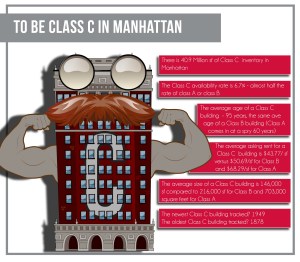 Ah, the Class C building. To put it delicately, it is considered…less than desirable. Typically, these properties require numerous upgrades and represent the most affordable alternatives in the market. In fact, Class C buildings are so easily dismissed by most that some brokerage firms don’t even bother to track their data.
Ah, the Class C building. To put it delicately, it is considered…less than desirable. Typically, these properties require numerous upgrades and represent the most affordable alternatives in the market. In fact, Class C buildings are so easily dismissed by most that some brokerage firms don’t even bother to track their data.
But that’s unfortunate, because Class C properties are currently outperforming their Class A and Class B brethren here in Manhattan.
Newmark Grubb Knight Frank tracks 40.9 million square feet—9.1% of Manhattan’s total inventory—of Class C product on the island. Percentage-wise it doesn’t sound like much, but in terms of square footage, that’s about the total office market size of Cleveland or Las Vegas.
Most of the space sits in the tech-happy Midtown South submarket, which largely accounts for the exceptionally narrow 6.7% availability rate. For the sake of comparison, Class B now stands at 11.2%, while Class A is 12.3%.
And those aren’t even all of the interesting or salient facts about Class C properties in Manhattan. There are many, many more. For instance:
- The average age of a Class C building is 95-years, which, interestingly enough, is the same average age of a Class B building (Class A properties average a more spry 60-years).
- The average asking rent for a Class C building is $43.77 per square foot, versus $50.69 per square foot for Class B and $68.29 per square foot for Class A.
- The average size of a Class C property is 146,000 square feet, compared to 216,000 square feet for Class B and 703,000 square feet for Class A.
- The smallest Class C buildings are about 20,000 square feet, while the largest totals 2.3 million square feet.
- The newest Class C building tracked went up in 1949.The oldest Class C building tracked? Built in 1878.
So, next time you see a somewhat older, less aesthetically appealing building, don’t pity the property. In today’s market, it’s actually faring a lot better than it’s more modern and adorned neighbors. I guess it’s true that looks, and modern amenities, aren’t always everything; or, at least, that beauty, when it comes to property, is in the eye of the beholder.


